Stone, minerals and semiprecious of the world stone
Silicate: Zircon -->rus
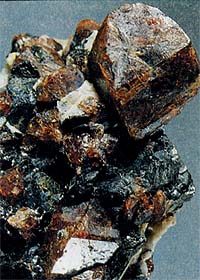 Diagnostic cart.
Diagnostic cart.
Two standards of zircon: the crystal habitus of this mineral is well visible as a short prism, square in a section.
Zr SiO4
Crystal structure tetragonal
Hardness on the Mohs scale 6,5-7,5
Specific unit weight mass 4,55-4,67
Cleavage not clear
Fracture, break padman
Colors colourless, polycoloured (multicoloured)
Colors in powder triturate white
Glance (glitter, glare) from glass to semidiamond

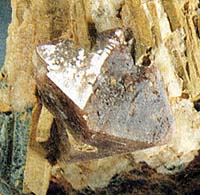 Zircon is known from ancient times. Got the name from Persian zargun - gold stone. High refraction and strong dispersion stipulate a bright game, near to the diamond. A mineral is very fragile and requires a carefulness at cutting. A considerable admixture of radio-active elements (U, Th) is reason of oscillation of physical properties.
Zircon is known from ancient times. Got the name from Persian zargun - gold stone. High refraction and strong dispersion stipulate a bright game, near to the diamond. A mineral is very fragile and requires a carefulness at cutting. A considerable admixture of radio-active elements (U, Th) is reason of oscillation of physical properties.
Green zircons under act of the radio-active elements contained in them sometimes suffer considerable changes and violations of structure, so that become almost amorphous (metamict, of or denoting the amorphous state of a substance that has lost its crystalline structure as a result of the radioactivity of uranium or thorium within it).
A hyacinth is a rather yellow-red or russet variety of zircon. Starlit is a blue variety, got artificially by burning. A reddish-brown, grey, green, blue, or colourless hard mineral consisting of zirconium silicate in tetragonal crystalline form with hafnium and some rare earths as impurities. It occurs principally in igneous rocks and is an important source of zirconium, zirconia, and hafnia: it is used as a gemstone and a refractory. Formula: ZrSiO4.
Brown Zircon of different tints, sometimes white, colourless, rarely red, green, yellow, gold, black. Zircon contains uranium and thorium - elements of radio-active group, able to radiate alpha-particles. Disintegration of radio-active elements condition damage of crystalline lattice in this semiprecious stone. On this account it is necessary to distinguish valuable zircons with an uncrippled crystalline lattice from those, whose lattice is damaged bombardment radio-active particles.
Valuable zircons are attributed to the "high type", while other group (its representatives, as a rule, are opaque or examine with x-rays) behaves to the "low type". First, usually transparent, orange-brown, rose, greenish, blue or colourless, used as jeweller stone.
The crystals of zircon have a short-prismatic habitus; completions are often crowned the verges of bipyramid (dipyramid). Rarer crystals can be extended or consisting only of bipyramid (dipyramid). Typical brilliance - from glass to semidiamond. Zircons differ not clear cleavage, padman fracture and enhanceable fragility. Colouring of zircons (which they are under an obligation radio-active and rare-earth elements) is especially sensible to heat treatment due to which from rose-brown it is possible to get wonderful blue or goldish yellow zircons.
Chemical composition (chemistry, compound)-maintenance (in %): ZrO2- 67,1; SiO2-32,9; the admixtures of hafnium (alvite), yttrium, cerium, phosphorus, niobium (naegite), tantalum, thorium, uranium are ordinary (malacon, cyrtolite). Transparency - is transparent (yellow, gold transparent Zircon is a hyacinth), translucent, opaque. Crystal structure - tetragonal, ditetragonal-dipyramid, bipyramid type of symmetry. Cleavage - non-existent or noperfect absolute on (110).
Occur in nature as the well cut pointed crystals of long-prismatic and dipyramid, bipyramid habitus. Main simple forms: (110), (100), (112), (101), (211) and (331). There are twins to on (101), rarely to on (111) and (211). The genicular are sometimes developed and cruciform, sheaf-like and radially-radiant accretions. Sizes of crystals usually small (a few millimetres), the large are consider zircons more than 1 sm.
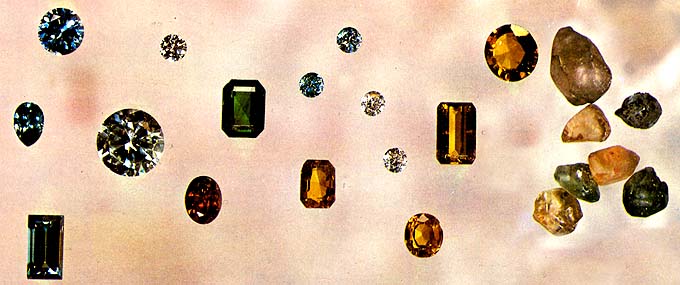
Diagnostic indication.
Some zircons are photosensitive. They lose colouring on to light and able to restore it, if them again to place in darkness. In nature more frequent than all there are greyish- and reddish-brown zircons; colourless stone are very rare. In the countries of South-east Asia by burning of brown varieties at 800-1000oC get colourless and blue zircons. Colouring, arising up at burning, not always is steady. Ultraviolet or sun light can cause its discolouring. Such minerals are alike on Zircon, as Aquamarine, Cassiterite, tinstone, toad's eye, Chrysoberyl, Hessonite (Cinnamon stone), Sapphire, Sinhalite, synthetic Spinel.
Origin provenance genesis.
Zircons are ordinary minerals of orthorocks, especially granit and appearing due to them metamorphic rocks. The crystals of small size appear in pegmatites. Main deposits of stone of jeweller quality - placer.
Deposit minefield mine field occurrence subsoil.
Industrial beds of jeweller stone are in alluvial pebbles shingle Sri Lanka, Burma and Thailand. The beautiful copies of zircon are found also in Australia, on Ural and in Norway. Deposit of minefield mine field occurrence subsoil zircon (mainly placer) meet in Kampuchea, Burma, Thailand, Sri Lanka, and also in Australia, Brazil, on Madagascar, in Tanzania, Vietnam and in France (Overhead Loire).
The use is on jeweller business.
As jeweller stone the transparent beautifully painted zircons are used. The stake of jeweller zircons makes an insignificant percent from all of volume of their booty. Zircons, except for colourless, are processed exceptionally as an oval or rotunda the mixed or diamond cutting, modified by addition of fasings, mainly in a large tent. Demand on zircons and their cost not stable, popularity of hyacinths is permanent. It is given colourless zircons usually diamond, and coloured - step cutting. Synthetic zircons are of interest only for scientific aims. Green zircons, rare at the market of jeweller stone, are very valued collectors.
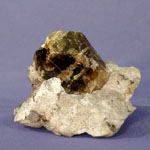
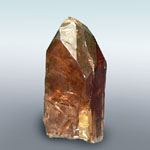
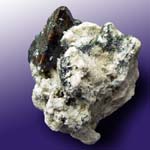
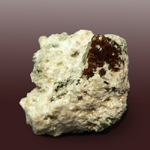
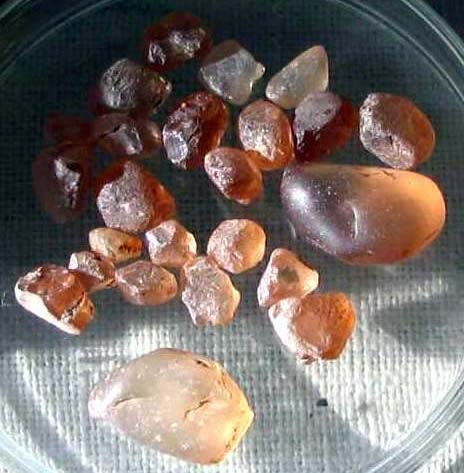
Zircon. Rounded grains from kimberlite. Russia. A photo: © A.A. Evseev.
 Dangerous "hazardous cargo", signs #1
Dangerous "hazardous cargo", signs #1 
Bomb which explode bursts
Can be characterized in a number of properties and effects, such as: by critical mass; by variation of fragments; intensive fire/thermal heat stream; bright flash; loud noise or smoke.
Sensitiveness to the shoves and/or shots and/or heat
To use shelter, here to repose on safe distance from windows
Orange sign, image of bomb at an explosion
Dangerous "hazardous cargo", signs #4.1 
Flammable hard solid substance matters, self-reactive matters and solid desensitized explosives
Risk of fire. Flammable or combustible matters can catch a fire from sparks or flame. Can contain self-reactive matters, apt at exothermic decomposition in the case of heating, contact with other matters (such as: acids, compounds of heavy metals or amines), to the friction or blow.
It can result in the selection of harmful or flammable gases or pair or spontaneous combustion. Capacities can burst at heating (dangerous, perilous - does not burn practically).
Risk of explosion of the desensitized explosives after the loss of desensitizer
Seven vertical red striaes on a white background, isometric, number of Dangerous "hazardous cargo", signs, black flame
Dangerous "hazardous cargo", signs #4.2 
Matters substances, apt at spontaneous combustion
Risk of fire as a result of spontaneous combustion in case if packing is damaged or the source of maintenance happened.
Can stormily react with water
White overhead half of rhombus, red - lower, isometric, number of Dangerous "hazardous cargo", signs, black flame
Dangerous "hazardous cargo", signs #3 

Flammable liquids
Risk of fire. Risk of explosion. Capacities can burst at heating (dangerous, perilous - burn easily)
To use shelter. To avoid the low areas of surface (pits, low-laying areas, trenches)
Red rhombus, number of Dangerous "hazardous cargo", signs, black or white flame
Dangerous "hazardous cargo", signs #5.1 
Matters substances, which oxidize
Risk of stormy reaction, self-ignition or explosion at a contact with combustible or flammable matters
To shut out formation of mixture of load with flammable or combustible matters (for example by sawdusts)
Yellow rhombus, number of Dangerous "hazardous cargo", signs, black flame above by a circle
Dangerous "hazardous cargo", signs #7 

Radio-active materials (radiation, Ukraine)
Risk of absorption of external and internal radiation irradiation
To limit time of influence, burns by a radiation, radiation exposure of photo- and the cinema material
Yellow overhead half of rhombus, white - lower, isometric, number of Dangerous "hazardous cargo", signs, black sign of radiation, inscription, title (text)
Dangerous "hazardous cargo", signs #7 


Dangerous "hazardous cargo", signs #7 


Radio-active materials
Risk of absorption of external and internal radiation irradiation, radiation burn
To limit time of influence, burns by a radiation, radiation exposure of photo- and the cinema material
White, yellow overhead half of rhombus, white - lower, number of Dangerous "hazardous cargo", signs, black sign of radiation, text
Active single-component (impoverished) radiation materials. White rhombus, one vertical red line down - there is not a nuclear military load (including simple h-bomb on a nuclear detonating fuse, impoverished uranium, burning war-head of "Kosovo", EU, single-component without a nuclear explosion). Jurisdiction is metrology of the Ukraine.
Yellow rhombus, two vertical red lines down is an active single nuclear charge (uranium, nuclear bomb on a type "Hiroshima", including multicomponent of the same type nuclear parts of single military load, single-component explosion and simple chain nuclear reaction - "two in one"). Jurisdiction is GAI of the Ukraine (Road Police Militia of the Ukraine) and war military law and order.
Yellow rhombus, three vertical red lines down - active double multi-component nuclear charge (plus heavy hydrogen-tritium, thermonuclear bomb of type the "Tihiy Pacific ocean", including nuclear parts of full-duplex military load, chain nuclear explosion and chain thermonuclear reaction - "three in one"). Jurisdiction - war military Road Police VAI of Ukraine and war military law and order.
Dangerous "hazardous cargo", signs #8 
Corrosive (caustic, pungent, acrid) substances matters
Risk of burns as a result of eating away of derma. Can stormily react between itself (components), with water and other matters. Matter, that spilled / scattered, can select a corrosive pair.
Make a danger for a water environment or sewage system
White overhead half of rhombus, black - lower, isometric, number of DOPOG, test tubes, hands
